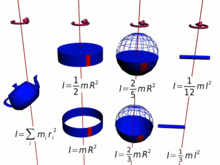Analogy to linear momentum

Angular momentum can be described as the rotational analog of linear momentum. Like linear momentum it involves elements of mass and displacement. Unlike linear momentum it also involves elements of position and shape.
Many problems in physics involve matter in motion about some certain point in space, be it in actual rotation about it, or simply moving past it, where it is desired to know what effect the moving matter has on the point—can it exert energy upon it or perform work about it? Energy, the ability to do work, can be stored in matter by setting it in motion—a combination of its inertia and its displacement. Inertia is measured by its mass, and displacement by its velocity. Their product,
is the matter's momentum. Referring this momentum to a central point introduces a complication: the momentum is not applied to the point directly. For instance, a particle of matter at the outer edge of a wheel is, in effect, at the end of a lever of the same length as the wheel's radius, its momentum turning the lever about the center point. This imaginary lever is known as the moment arm. It has the effect of multiplying the momentum's effort in proportion to its length, an effect known as a moment. Hence, the particle's momentum referred to a particular point,
is the angular momentum, sometimes called, as here, the moment of momentum of the particle versus that particular center point. The equation combines a moment (a mass turning moment arm ) with a linear (straight-line equivalent) speed . Linear speed referred to the central point is simply the product of the distance and the angular speed versus the point: another moment. Hence, angular momentum contains a double moment: Simplifying slightly, the quantity is the particle's moment of inertia, sometimes called the second moment of mass. It is a measure of rotational inertia.
Because moment of inertia is a crucial part of the spin angular momentum, the latter necessarily includes all of the complications of the former, which is calculated by multiplying elementary bits of the mass by the squares of their distances from the center of rotation. Therefore, the total moment of inertia, and the angular momentum, is a complex function of the configuration of the matter about the center of rotation and the orientation of the rotation for the various bits.
For a rigid body, for instance a wheel or an asteroid, the orientation of rotation is simply the position of the rotation axis versus the matter of the body. It may or may not pass through the center of mass, or it may lie completely outside of the body. For the same body, angular momentum may take a different value for every possible axis about which rotation may take place. It reaches a minimum when the axis passes through the center of mass.
For a collection of objects revolving about a center, for instance all of the bodies of the Solar System, the orientations may be somewhat organized, as is the Solar System, with most of the bodies' axes lying close to the system's axis. Their orientations may also be completely random.
In brief, the more mass and the farther it is from the center of rotation (the longer the moment arm), the greater the moment of inertia, and therefore the greater the angular momentum for a given angular velocity. In many cases the moment of inertia, and hence the angular momentum, can be simplified by,
- where is the radius of gyration, the distance from the axis at which the entire mass may be considered as concentrated.
Similarly, for a point mass the moment of inertia is defined as,
- where is the radius of the point mass from the center of rotation,
and for any collection of particles as the sum,
Angular momentum's dependence on position and shape is reflected in its units versus linear momentum: kg⋅m2/s, N⋅m⋅s, or J⋅s for angular momentum versus kg⋅m/s or N⋅s for linear momentum. When calculating angular momentum as the product of the moment of inertia times the angular velocity, the angular velocity must be expressed in radians per second, where the radian assumes the dimensionless value of unity. (When performing dimensional analysis, it may be productive to use orientational analysis which treats radians as a base unit, but this is outside the scope of the International system of units). Angular momentum's units can be interpreted as torque⋅time or as energy⋅time per angle. An object with angular momentum of L N⋅m⋅s can be reduced to zero rotation (all of the rotational energy can be transferred out of it) by an angular impulse of L N⋅m⋅s or equivalently, by torque or work of L N⋅m for one second, or energy of L J for one second.
The plane perpendicular to the axis of angular momentum and passing through the center of mass is sometimes called the invariable plane, because the direction of the axis remains fixed if only the interactions of the bodies within the system, free from outside influences, are considered. One such plane is the invariable plane of the Solar System.
Angular momentum and torqueedit
Newton's second law of motion can be expressed mathematically,
or force = mass × acceleration. The rotational equivalent for point particles may be derived as follows:
which means that the torque (i.e. the time derivative of the angular momentum) is
Because the moment of inertia is , it follows that , and which, reduces to
This is the rotational analog of Newton's Second Law. Note that the torque is not necessarily proportional or parallel to the angular acceleration (as one might expect). The reason for this is that the moment of inertia of a particle can change with time, something that cannot occur for ordinary mass.























Comments
Post a Comment